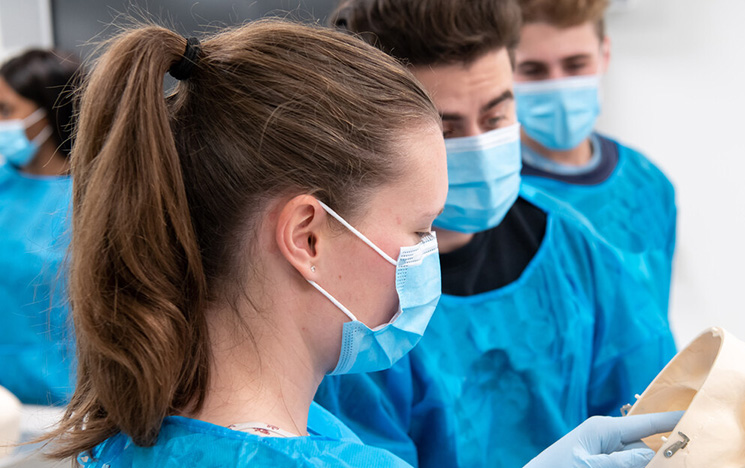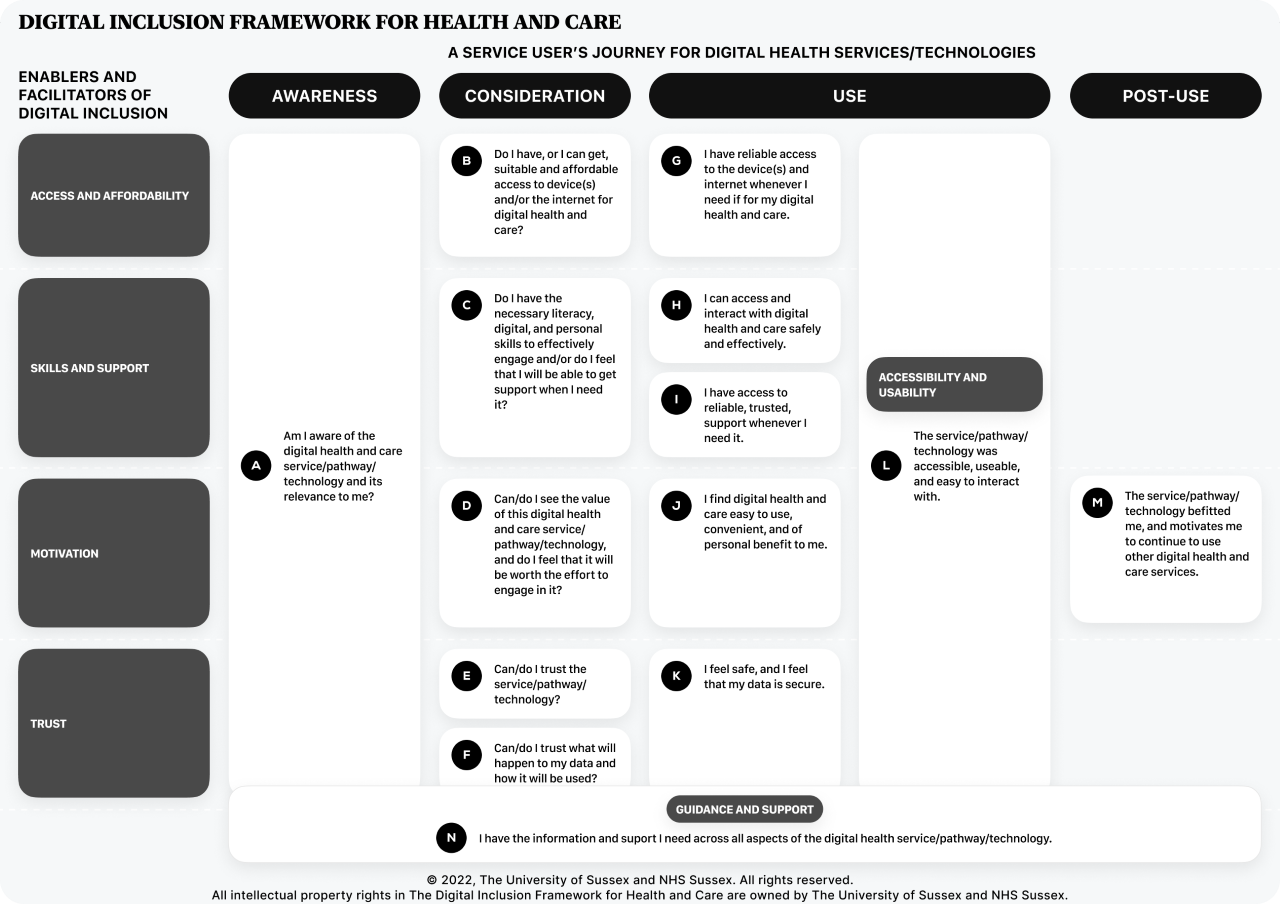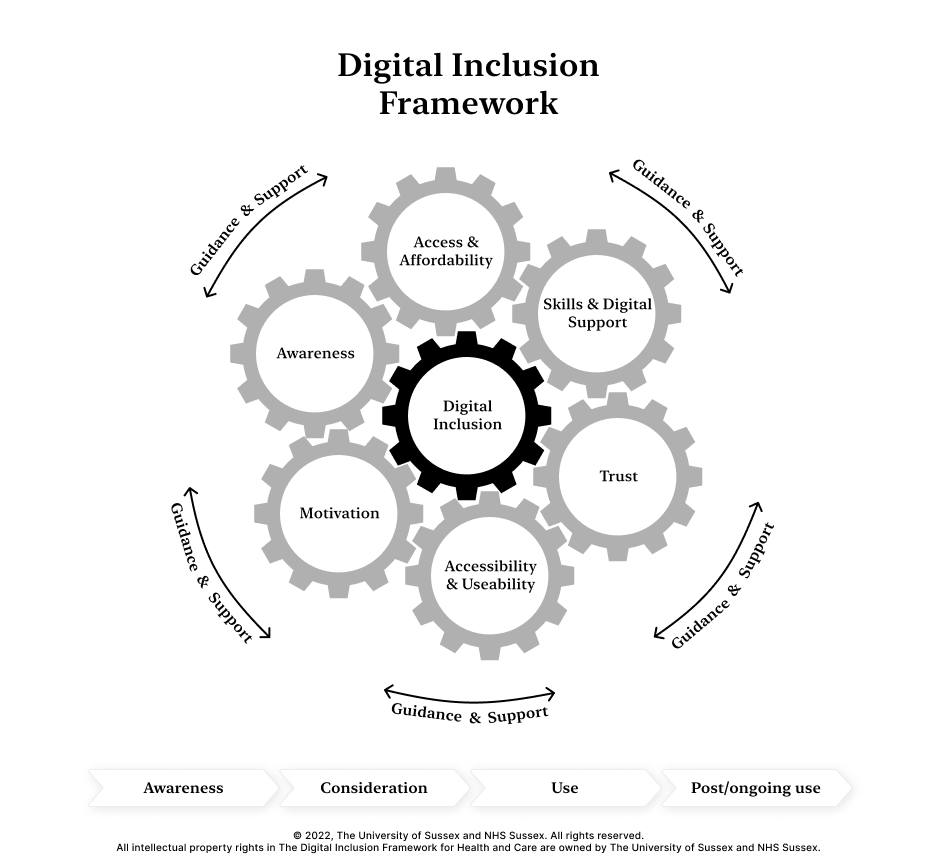Expertise, consulting and commission research for public and third sector
Find out how we can help you grow your public or third sector organisation by connecting you with our cutting edge expertise.

How we can help you
From businesses to charities and local authorities to government departments, we have a strong track record of working with a range of partners.
Our experts can help you:
- research and generate new ideas to overcome a complex challenge
- support you implement knowledge that is new to your organisation
- evolve your practice in new ways that achieve the best results.
Digital inclusion in health and care
A recent collaboration has addressed digital inclusion in health and care.
Digital inclusion framework
- Video transcript
[Mike, Workshop Attendee holds phone. He looks at the NHS app on his mobile phone.]
Mike: There we go. We've got help.
[On screen name caption: Kath Sykes – NHS Sussex]
Kath Sykes: There’s massive digital transformation in the NHS, and it really will support people to self-manage their health in a way that we would just not be able to do face to face. As an example, you know, people can have access to apps that provide them with information that could prevent them from needing to see a GP, help them manage long term conditions, as well as access health and care services.
[Mike, workshop attendee, uses NHS app to order a prescription on his mobile phone]
Mike: All done in just a few minutes sitting in the living room.
[On screen caption: Mike, workshop attendee]
Mike: If the NHS is going to roll this technology out, it does need to think about how it makes it robust for users who are not tech savvy. I haven't grown up with this technology, I use it, but I wouldn't have been able to download that the app without my daughter's help.
Kath Sykes: So we know that 40% of adults over 75 are digitally excluded. We know that one in 20 households in the UK don't have internet access, or will struggle to afford internet access. So the digital inclusion framework is important because it enables us really to think about the impact on that person, whether they're being excluded, whether we're introducing health inequalities, and make them much more inclusive for people.
[On screen caption: Maja Golf-Papez – Univeristy of Sussex]
Maja Golf-Papez: So this is the framework that can be used as a thinking tool that helps us to better understand what are some potential barriers to people being included in the healthcare technologists services. And we can use this framework to first ensure that we design digital health and care pathways in an inclusive way and also assess current pathways, whether they are inclusive or not.
[Doctor on video call]
Doctor: Hi, there. Hi, Rachel. Hi, Richard, how you doing? Good. How are you?
[On screen caption: Debbie Keeling – University of Sussex]
Debbie Keeling: In terms of what we wanted to achieve, there were two stages, the very first stage was that we realised that we potentially had the experience and the expertise in a multi-partner collaboration to raise awareness about digital engagement. And so we then started to explore with patients and their carers, how they engage with health services. That all pointed to the fact that there was a journey that could be mapped out, that there were very common themes, as opposed to breaking it down into different healthcare pathways or different conditions. Looking at it from a lived experience point of view, we were very motivated by that, because quite often the starting point is the technology without considering the person.
[On screen caption: Jessica Van Thiel – University of Sussex]
Jessica van Thiel: I think what we've tried to achieve here is not just saying, if you're of a certain age or a certain gender, this is going to be your problem. It’s very complex and it's all very interrelated, and that's where I think the Digital Inclusion Framework is very different is because we've tried to listen to as many people as possible, and consider the overlapping variables as well. And eliminating, I think, those quite siloed approaches, we're trying to look at it in a very holistic way. And there's always going to be a certain population that really just aren't motivated to onboard new technology, but we're talking about quality of life, which will impact their health going forward. So getting it right is essential. If we don't get digital health care right it's such a missed opportunity, and so I think the implications here are massive.
[On screen caption: Lilian – Workshop Attendee]
Lilian: My husband has a disability, which is a benign quiver, so he shakes a lot and he doesn't use the internet much, and he doesn't have a smartphone. So I tend to do the banking, and he does tend to not have too much problems pressing buttons on his remote control for the TV. I keep telling him if anything happens to me, what would you do? And I think it might be as we're getting a bit older that he's beginning to worry about.
Maja Golf- Papez: Technology can be a solution but technology is often also the problem, and what we don't want is that technology adds to the problems and creates new problems. And anybody is at risk to be excluded from digital health and care because they're not aware of the digital healthcare solutions or technologies or pathways. Others might be excluded in the process when they are using things and they just don't get enough support for the use, and still others might be excluded just because when they're using it, then they lose the motivation to keep using it. So these things, they cannot be a replacement of human support. So even when people submit their readings via app for the blood pressure, they will be eagerly waiting to hear back from the GP to tell them what is the next action. So this might become overwhelming for somebody and they just say I can't be bothered, so I'm not using this solution. We would like to have better technology that solves the problems and not just create new ones. So our framework won't be just like an academic tool that it's nice to look at, but it's something that can really make a difference out there in the real world.
[End card. NHS Sussex University of Sussex, Kent Surrey Sussex Academic Health Science Network logos.]
The University of Sussex in collaboration with NHS Sussex and the Kent, Surrey and Sussex Academic Health and Science Network has developed a digital inclusion framework for health and care.
This person-centred guide supports the design of digital services, taking into account lived-experiences and people’s needs. It considers the barriers and enablers that people face in their daily lives that affect their ability to engage with digital health and care services. This is important because research into digital exclusion shows that there are correlations between the populations more likely to be digitally excluded and those more at risk of health inequalities.
The overall aim of the framework is to enable everyone that can benefit from digital health and care to do so, when they need to, and to ensure that inaccessible pathways and technologies are not creating barriers and causing disengagement in digital health and care.
The work is continuing and the team are developing tools and resources to help NHS partners use the framework, working with innovators to embed the principals of the framework in the process of designing digital services and building up awareness with the public.
Find our more by contacting: University of Sussex: esrc-iaa@sussex.ac.uk or NHS Sussex: sxicb.comms@nhs.net.
Read more about the digital inclusion collaboration and its accompanying framework.
- Contributors
Project team
Dr Maja Golf-Papez, University of Sussex
Katherine Sykes, KSS AHSN
Professor Debbie Keeling, University of Sussex
Jessica Hadjis van Thiel, University of Sussex
Dr. Ralitsa Hiteva, University of Sussex
Nora Davies, University of SussexNHS Sussex colleagues
Virtual health and care team
Population health and prevention team
Digital teams
Ageing well team
Musculoskeletal team
ACF PCN
Sussex Partnership Foundation Trust
Engagement teams
Public reference group members
Local authority digital inclusion teams
Healthwatch.Other acknowledgements
Kent Surrey Sussex Academic Health Science
Network
Participants of co-creation workshop
Library services across Sussex
Various NHS, VSCE, health and care, accessibility, and digital inclusion programmes and agencies
Participants in the video.
Digital inclusion in health and care framework
The diagram below suggests that the likelihood and the nature of exclusion will differ in accordance with the individual's journey with digital health and care.

Download the digital inclusion in health and care framework table as a PDF [3.31MB]. You can see an accessible version of the PDF and the table above, below.
- Accessible version of table
N. I have the information and support I need across all aspects of the digital health service/pathway/technology (Awareness, Consideration, Use, Post Use and accessibility and usability).The Digital Inclusion Framework for Health and Care
Patient’s journey for digital health services/technologies
Enablers and facilitators
of digital inclusionAwareness Consideration Use Post-use Access and Affordability B. Do I have,
or I can get,
suitable and
affordable access to device(s) and/or
the internet for
digital health
and care?G. I have reliable access to the device(s) and internet whenever I need if for my digital health and care. Skills and
SupportC. Do I have the
necessary literacy,
digital, and personal
skills to effectively
engage and/or
do I feel that I
will be able to
get support
when I need it?H. I can access and interact with digital health and care safely and effectively.
I. I have access to reliable, trusted, support whenever I need it.
A. Am I aware of
the digital health
and care service/pathway
/technology and its
relevance to me?Accessibility and Usability
L. The service/pathway and technology was accessible, usable, and easy for me to interact with.
Motivation D. Can/do I see the
value of this
digital health and care service/pathway
/technology
and do I feel that
it will be worth
the effort to
engage in it?J. I find digital health and care easy to use, convenient, and of personal benefit to me. M. This service/pathway
/technology befitted me, and motivates me to continue to use other digital health and careTrust E. Can/do I trust
the service/pathway
/technology?F. Can/do I trust what will happen to my data and how it will be used?
K. I feel safe, and I feel that my data is secure. © 2022, The University of Sussex and NHS Sussex. All rights reserved. All intellectual property rights in The Digital Inclusion Framework for Health and Care are owned by The University of Sussex and NHS Sussex.
The diagram below shows the interconnected enablers that we need to consider when designing and evaluating digitally inclusive health and care pathways, services and technologies.

Download the digital inclusion in health and care framework diagram as a PDF [260KB].
The Connected Lewes Project
The Connected Lewes project is a partnership between the University of Sussex, Lewes volunteer groups that work in partnership with Lewes Town Council, the NHS GP practice – The Foundry, and local charities.
The research team involved Jessica van Thiel, George Han (both postgraduate students at SPRU) and was led by Dr Ralitsa Hiteva, a Senior Research Fellow at SPRU.
The aim of the project was to identify the social and communication needs of older people in Lewes during the Covid-19 lockdown, to inform appropriate solutions and actions at the local level (The office of the Mayor of Lewes, East Sussex County Council and local formal and informal stakeholders).
- Video transcript
Dr Ralitsa Hiteva: The aims and objectives of the Connecting Lewes project was to do a survey with as many of the residents in Lewes over the age of 55 as possible. And we wanted to find out specifically how they using digital technologies in order to stay in touch during one of the longer lockdowns in 2021, to help them develop their digital inclusion work in Lewes.
[Pictures are displayed showing shots of Lewes including the High Street, and Lewes Castle]
Eric Kihlstrom (UK Ambassador Ageing 2.0 and resident of Lewes): I had a neighbour who is a GP has lots of patients who are frail, elderly and when lockdown happened, they were quite worried about how those patients were going to receive care during lockdown and isolation.
[Picture shows a man and a woman using a computer, another picture of a woman using a mobiile phone and another picture of a person sitting in a dining room using a desktop computer]
Eric Kihlstrom: Their digital skills, their access to digital technology was a real question, and so I connected with the mayor of Lewes, also Sussex University who were extremely helpful in putting together a project that had academic rigour, but also delivered results for the community.
[Picture shows a man using a tablet and a woman using a laptop computer sitting next to each other on the sofa in front of a wood burning stove]
Dr Ralitsa Hiteva: We all realised that the advance of digital technologies that was forced during the pandemic was not something that was going to be rolled back, and this is also the point at which we started seeing that it's not enough to give people smart tablets, and smartphones and expect them to be able to have the same level of access to services as before.
[Displays pictures of people accessing services to help them with digital technology and getting help from volunteers]
Dr Ralitsa Hiteva: One of the things we didn't set out to study and to learn is the big role that voluntary organisations and local level organisations can actually play to support any kind of either national level or local level programs, they were essential in how we reached out to people, how we actually managed to collect the data. And they were also the people that managed to bring in a lot of the stakeholders to the table.
[Picture shows a copy of Lewes News with the two page spread about the project]
George Han (Researcher in Sustainable Development at Sussex): With a piece of research on digital exclusion in the elderly, we wanted to choose a method that they'd be able to respond. So we had a two page spread in Lewes News then did a slightly smaller follow up with the same questions online. And I think one of the interviews really highlighted the fact of closing down public facilities such as libraries during COVID make it much harder for people to access these technologies that they need for benefits claims and things like that.
Jessica Hadjis Van Thiel (PhD Researcher at Sussex): The specific findings were related to age, health and gender. When we talk about gender, I think the difference was really in terms of perception. And in terms of confidence men felt or the perception was that they felt pretty confident in using the technology.
[Picture shows two men looking at a laptop computer. Another picture shows a woman using a mobile phone]
Jessica Hadjis Van Thiel: And women generally, were under confident or were less confident but then when when we actually broke it down into questions afterwards, we found that actually women were the ones that were doing most of the communicating that were using most of the devices or that were using it for longer periods of time, or that were doing, you know, most of the household technological chores, if you will. So that was quite interesting.
[Picture shows woman sat on a sofa using a laptop]
Dr Ralitsa Hiteva: It means that if you get working with this, you know, supporting this group, right, it's likely it's going to have a very positive effect on everyone in the household. We found out a lot of things that we were very genuinely surprised to find out.
[Picture shows a man in a warehouse wearing high vis clothing and using a desktop computer. Followed by another picture of a woman smiling as she stands in her kitchen. Followed by another picture of an elderly man using a laptop]
Dr Ralitsa Hiteva: So apart from the importance of radio sets and the importance of smartphones, we also see that obviously as people grow older, and we're dealing with older age groups, the extent to which their health actually deteriorates, plays a very big role on the extent to which they will be able to use the digital technologies in a particular way.
[Picture shows a man sitting in a cafe at a table using a mobile phone. Followed by another picture of two men sat at a table with mugs of tea using a laptop together]
Eric Kihlstrom: There are five million people in the UK who have never used the internet. Two thirds of them are over 65. Some of it is skills, a lot of it is motivation, some of it is affordability. One thing that I think for me is really important is the leveraging of the social infrastructure that we've got, the trusted social networks. For as much as we talk about technology, it's about people and people should be at the centre of all of our work, and we can address digital inclusion as result of community and community building.
With thanks to Lewes Town Council, The Foundry NHS GP Practice, Lewes Community Volunteers, Lewes News, University of Sussex and local charities. Lewes footage courtesy of www.youtube.com/@Living walks. Photos courtesy of Centre for Aging Better.
You might also be interested in:
Contact
If you have any queries, email collaborate@sussex.ac.uk.